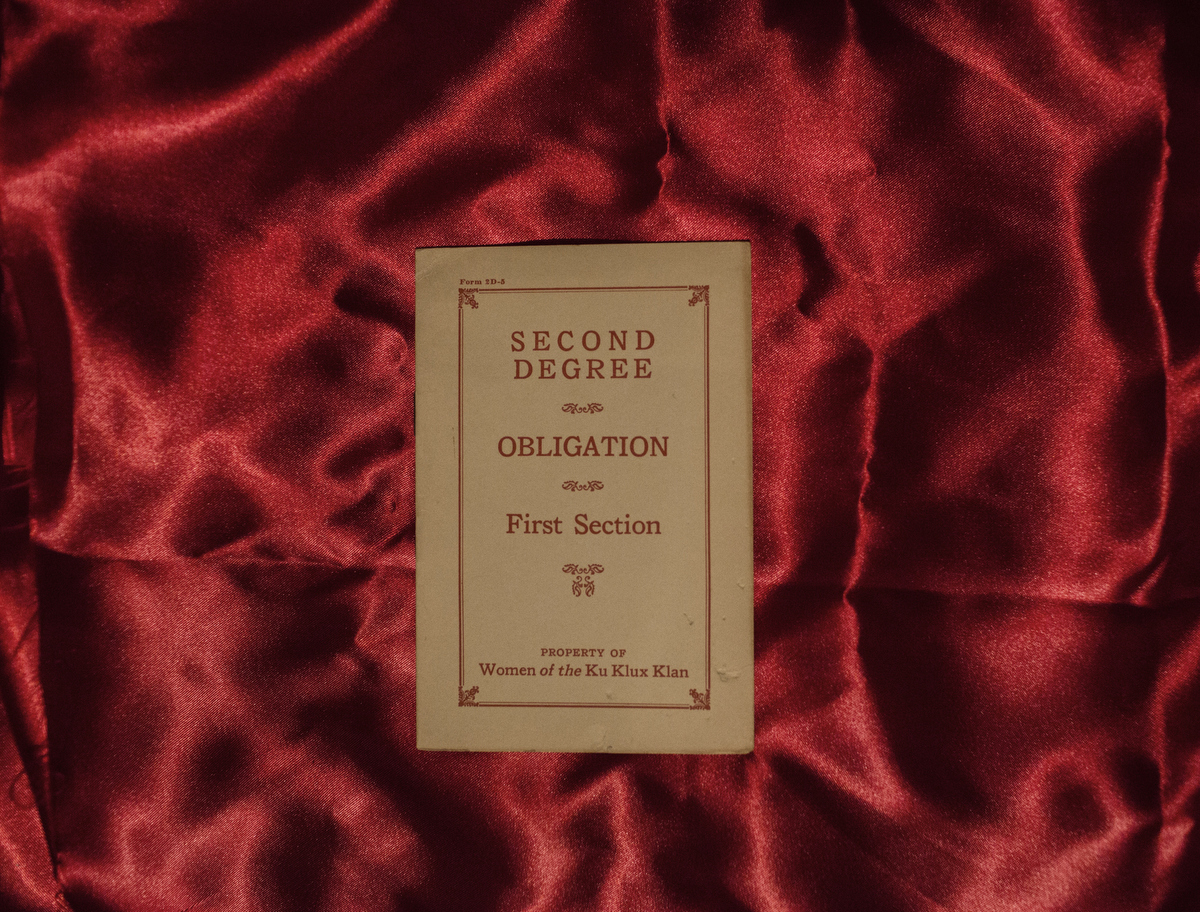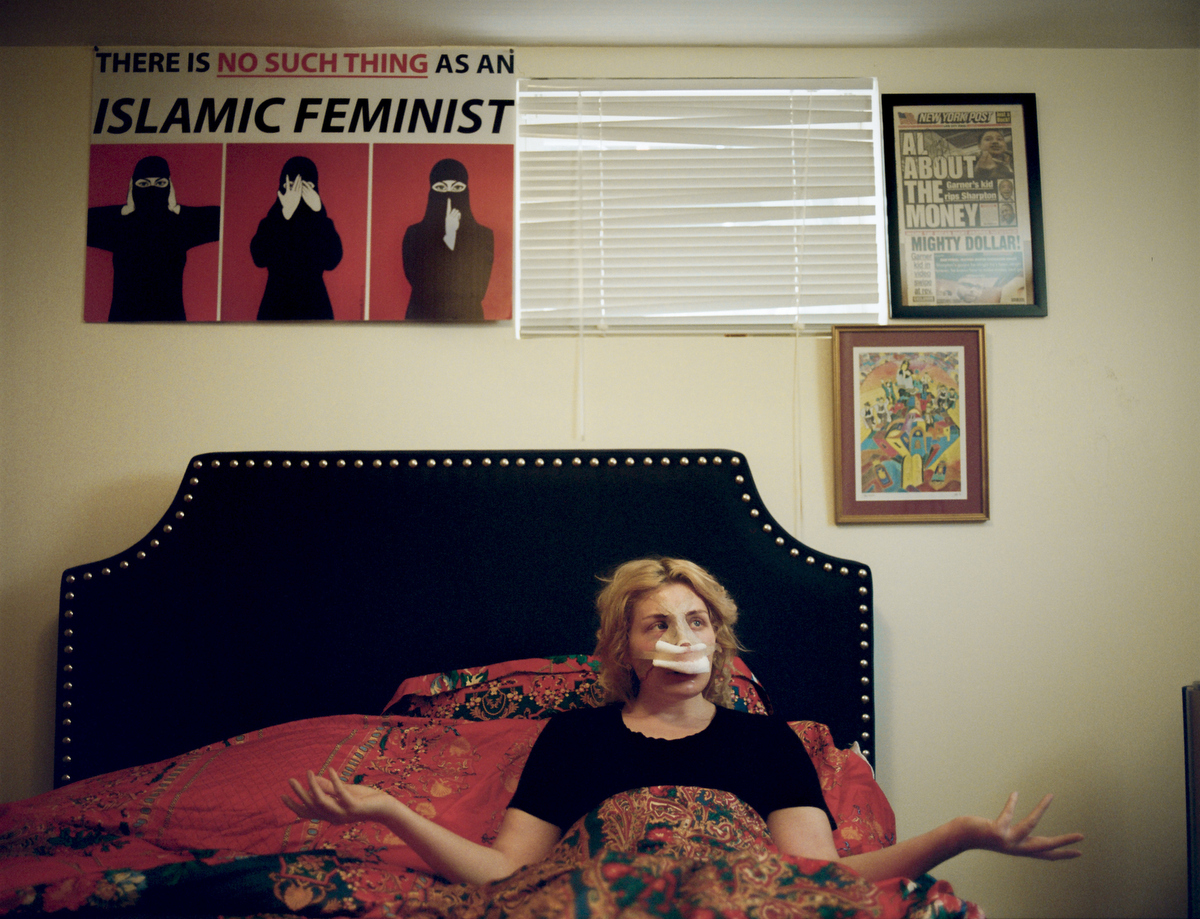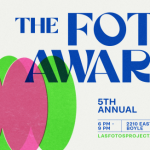Glenna Gordon: Winner of the 2019 Aftermath Grant

©Glenna Gordon, “A Wife With a Purpose,” the online super star Ayla Stewart, poses for a portrait at a public park in Tennessee on August 23, 2017 along with her six children. She’s known for promoting #tradlife (traditionalist homemaking and white culture). She’s been kicked off twitter for hate speech, though has started accounts on Gab and other platforms, and continues to have a huge youtube following. Though she believes there are many definitions of the word Nazi, she says there is only one definition of the word racist and she claims she is not racist.
We must face our past and examine our present. We must look people in the eye, and engage with those with whom we disagree. The only way out is through, and the only way to reconcile our nation is to understand both the forces that are tearing it apart and the people trying to put it back together. – Glenna Gordon
The Aftermath Project is a non-profit organization committed to telling the other half of the story of conflict — the story of what it takes for individuals to learn to live again, to rebuild destroyed lives and homes, to restore civil societies, to address the lingering wounds of war while struggling to create new avenues for peace. The Aftermath Project holds a yearly grant competition open to working photographers worldwide covering the aftermath of conflict. The 2019 winner of the $25,000 Grant is Glenna Gordon, for her project, American Women, which is an extension of her work covering the women of the alt-right movement and the post-Civil War legacy of white supremacy and hate in the U.S. The jurors for this year’s grant were Aftermath founder Sara Terry; photographer, writer and founder of The Candid Frame, Ibarionex Perello; Aline Smithson, photographer and editor of Lenscratch; and Todd J. Tubutis, Associate Director at Sheldon Museum of Art, soon to be Director at the Art Museum of West Virginia University.
With her Aftermath grant, Glenna will be covering the women who live in the same communities as the alt-right women — but who are fighting for social justice, healing and change. As Glenna states, “Men may hold the highest officers and the most power, but from Alexandria Ocasio-Cortez to Amanda the “Den Mother,” of the League of the South, it is women who do the work of change. They raise the next generation. They pave whichever path we as a nation may decide to take…..I hope to create conversations that grapple directly with our nation’s unhealed wounds.”

©Glenna Gordon, Amanda, the “den mother” of the League of the South, a neo-confederate group that publicly advocates for southern succession, and privately endorses slavery. This portrait was made at their annual convention in Wetumpka, Alabama on June 30, 2017. The League of the South takes great pains to distance itself and differentiate from the KKK, yet promotes many of the exact same ideas under a different outward facing rhetorical stance. The argument about ÒopticsÓ pits different hate groups against each other as they vie for local power. LOS is almost completely male in its power structure and women like Amanda can only play informal roles. Amanda is not from the south but when she met her now husband online as his nutritionist and moved to Mississippi to be with him, she joined. She said that all the people at the meeting (which did include Klan members) were the greatest people she’d ever met. This reporter was forcefully ejected and escorted out of the meeting without clear cause.
One of the best things about judging the Aftermath Project grant is reviewing a proposal that surprises me – the aftermath idea is so unexpected, the imagery so strong, that it forces me (nearly 20 years after beginning my own work on aftermath stories) to consider aftermath in a whole new light.
That’s what happened when I read Glenna Gordon’s grant-winning proposal, “American Women.” A project that began as a relentlessly researched and pursued project about the role of women in shaping the extremist views of the far right, had been expanded by Gordon to include the progressive activist women who live in the same area – even the same neighborhoods – as the extremists she had photographed. The idea of a shared geography, a common landscape that birthed two different ways of experiencing what it means to be American – and how to explore that landscape – was a way of looking at the aftermath of the Civil War, and America’s legacy of racism, that I had never even thought of. And to consider that theoretical and literal landscape through the eyes of women was even more thought provoking.
The work you’ll see here is from the first phase of Gordon’s work – portraits and landscapes of women of the far right. In the year ahead, with her grant from the Aftermath Project, she’ll be expanding on that work, and also documenting the progressive women who are fighting for social justice in the very same spaces where women of the far right work to promote a racist ideology.
I can’t wait to see what she sees. – Aftermath Project and Grant Founder, Sara Terry

©Glenna Gordon, Elaine Willman hosts community leaders in her “War Room,” which is what she calls the basement of her Montana home. Though many insisted that they were racist and saw no color at all, they also spent time that day in and in their lives protesting immigrant rights and the advancement of Native Americans. Elaine’s home is covered in Native American art, and she insists she loves the people, just doesn’t like the tribal leadership.
Glenna Gordon is a documentary photographer and photojournalist. She’s been commissioned by the New York Times Magazine, Time Magazine, The Wall Street Journal, Le Monde, and many other outlets.
She won a World Press Award in 2015, was a finalist for the Eugene Smith Award in 2017, and others. She is also a lecturer at The New School in New York, where she received the 2017-2018 Faculty Research Fund, and a partner at the publishing collective Red Hook Editions.
Her book DIAGRAM OF THE HEART was released by Red Hook Editions in February 2016 and was a photobook of the year for the New York Times Magazine, POYi, and others. The work was included in “Moving Walls 23: Journeys,” shown at the Museum of Contemporary African Diasporan Arts (MoCADA) in Brooklyn, New York, and elsewhere.

©Glenna Gordon, While many who are active in pro white politics today eschew directly racists rhetoric or imagery, hiding it under layers of other issues like land use, the KKK still actively embraces racist symbols and works to promote hatred, fear, and bigotry in all that they do. While they argue they are a civil rights group and a charity group, this too is a layer of false rhetoric that hides their actual goals. It is important to note that they do engage in outreach and community involvement, and this is the work of women and it helps keep people involved in racist activism.
American Women
“The echoing horror of slavery cuts both ways,” Imani Perry
On June 22, 2017, I flew from New York to Atlanta, grabbed a rental car and headed to a budget motel at the intersection of Highways 85 and 231 in Montgomery, Alabama. The next day, I headed twenty miles north on the 231, and 150 years back in time to a moment before America’s Civil War.
I was headed to the annual convention of the League of the South, a hate group that believes that slavery wasn’t so bad and the South should still try and secede. My goal was to document the women who lead and participate in hateful or racist groups on the far right, in an in-depth, long-term project.
Women provide the far right with a dangerous, and seldom examined, veneer of femininity, domesticity, and normalcy that helps accomplish their toxic agenda.

©Glenna Gordon, Amanda Barker, known as Imperial Komander Amanda, married Chris Barker, her high school sweetheart, who is the Grand Dagon of the Loyal White Knights, one of the most active chapters of the KKK in the country. Though Chris is the public face, it is widely acknowledged that Amanda does the bulk of the work to keep the operation afloat. Chris has an incredibly long criminal wrap sheet, which includes multiple accounts of beating Amanda up, but is seldom convicted in a court of law as he is thought to also be an FBI informant.
In Wetumpka, the one-road town where the convention was held, there were Klansmen, tattooed greasers, and burly men in fatigues. There were also well-dressed southern ladies, and men in button-downs and khakis. The mood was angry as speakers like David Duke and Hunter Wallace and others riled up the crowd.
I was forcefully ejected and escorted out by armed heavily armed men before 3 pm. Shaking, I drove to the nearest motel parking lot and hyperventilated until I puked.
On Sept 20, 1028, I retraced my steps from Brooklyn to Atlanta to Montgomery, to the same intersection of Highways 231 and 85, to a budget motel directly across from where I’d stayed a year earlier. This time, I took Highway 85, the Martin Luther King Expressway, ten miles east and toward a radically different vision of America’s future.

©Glenna Gordon, A klan document from the 1920s, photographed in rural North Carolina at the home of the Grand Dragon of the Loyal White Knights of the Ku Klux Klan, on August 18, 2017. Some of America’s most prominent suffragists used their political experience to become leaders in the Ku Klux Klan of 1920s, when the organization was at its peak with as many as four million dues paying members.
This time, I was covering Tabitha Isner for the New York Times Magazine. She was a long-shot progressive Democratic candidate for Congress, facing a ten-year Republican incumbent.
We spent the weekend on the campaign trail, in black churches and community centers. Everywhere we went, people were welcoming and excited to see a candidate who stood for change and wanted to represent them. We were given heaping plates of BBQ and macaroni and cheese. We were embraced, encouraged and acknowledged.
On Sunday morning of my weekend with Isner, I sat next to her in a pew at historic black church in a city rich with history and the legacy of the Civil Rights Movement, and lowered my head. I struggled to hold back the tears. Going to Montgomery the second time had been an opportunity for synchronicity – I saw the same exact geography through an entirely different perspective.

©Glenna Gordon, Laura Loomer, an anti-Islam activist, is unique in her role in the extreme right because she is Jewish. After being continuously trolled by David Duke and others, which included pictures posted of her photoshopped in to gas chambers, she decided to get a nose job so she could further her own agenda without appearing so Jewish. Her antiIslam activism drives islamophobia in the USA, and she also plays the important role of victim within the far right twittersphere. Lauren Southern and others enjoy taking pot shots at her, and Pamella Geller was quick to distance herself from the toxic Loomer as well.

©Glenna Gordon, Tara Bradley poses for a portrait in her official Òmourning gearÓ. She is a member of a group called the Order of the Confederate Rose. Though similar to groups like Daughters of the Confederacy, members of this group insist that they are not political and are open to all people. . On April 21, the group laid wreathes at a Confederate cemetery in Raymond, Mississippi for Confederate Memorial Month. The keynote speaker from the local Sons of Confederate Veterans group mentioned Hitler, the KKK and David Duke in his speech. One member of the Roses left in the middle, but it was later discovered that she did not leave in protest but because her feet hurt. After the ceremony, when pushed on dressing up as confederate slaveholders, members repeated false statistics like only 5 percent of Southerners owned slaves (in Mississippi, it was 55 percent), and argued that people also dress up as Union soldiers. When it was pointed out that no one dresses up like slaves, one woman exclaimed, “We’d love to have someone that would! All of the women present boasted about volunteer work and civic duty and none thought their costumes or activities were racists or offensive. Groups like the OCR help keep the traditions of the Confederacy and it’s racists policies alive and well.

©Glenna Gordon, Barbie Rogers, who runs the Patriot Information Hotline, which is a one woman outfit that connects people wanting to join the movement to their local militia groups. Though women like RogerÕs do not base their political activism around racist ideology, she holds certain racist beliefs, is staunchly antigovernment, anti immigrant, and is upset that the SPLC supposedly only lists her in their top 500 activist, not top 100 activists. (They do not list her at all on their hate map, though she is briefly mentioned in a blogpost from 2015 on nativist groups.) Rogers has been involved in citizen militia efforts to patrol the border and in recruitment for the group.

©Glenna Gordon, There’s domesticated bobcat, named Fancy, who apparently often licks Manzella’s feet.

©Glenna Gordon, Barbie Roger’s house has a sign that says “We Don’t Dial 911.” Barbie spends all day on the internet and facebook and promoting the hotline and spreading “information.”

©Glenna Gordon, Clarice Ryan is a wealthy donor in Montana politics, which in a sparsely populated state, gives her a large amount of sway. She is a proponent of conspiracies around Agenda 21 (a non binding UN resolution about climate change) and believes that the federal government is usurping rights through a land grab. She also actively demonstrates against immigrants and Muslims, and is against sharia law coming to Montana, a common platform for conservatives in the predominantly white and Christian state.

©Glenna Gordon, Though members of the clean cut group Identity Evorpa are technically not supposed to have tattoos, that didn’t stop Erika from joining. Her chest tattoo says, I will never be silenced. Like many on the far right, she believes she is unfairly censored by liberal tech companies and politically correct culture. The night of Charlottesville, she was the host of an IE party at a vacation rental home on the outskirts of the city. Though someone had died that day and many others were injured, IE partied hard. The ratio of men to women was about 15 to 1, but the women who were present bragged of enjoying the male attention and of their desire to preserve traditional feminine roles. Erika made sure the party ran smoothly and all could celebrate that day.

©Glenna Gordon, Amid intense arguments about optics, many groups on the far right insist that they are not Nazis and do not publicly use swastikas. Privately, many do this often and with irony. Image provided by a woman who dated a leader in one of the groups largely responsible for the violence at Charlottesville last year, who has since left the movement. Her ex boyfriend has also been outed for lying about his military record, but their group continues under new leadership.

©Glenna Gordon, Irma Hinojosa is the kind of woman who complicates the way we understand far right activism she is the head of Latino’s With Trump, and while she argues that she supports legal immigration, much of her rhetoric is strongly anti immigrant and pro border and security. She live casts, youtubes, and creates content constantly for her nearly 100,000 followers. At a freedom of speech rally in Washington DC organized by Richard Spencer and well known anti semite Baked Alaska, where someone gave a shout out to John Wilkes Booth in front of the Lincoln Memorial, she was the only woman who spoke on a line up of nearly ten people.
Posts on Lenscratch may not be reproduced without the permission of the Lenscratch staff and the photographer.
Recommended
-
The International Women in Photo Association Awards: Lorraine Turci: The Resilience of the CrowMarch 16th, 2024
-
The International Women in Photo Awards: Natalia Garbu: Moldova LookbookMarch 15th, 2024
-
The International Women in Photo Association Awards: Rayito Flores Pelcastre: Chirping of CricketsMarch 14th, 2024
-
The International Women in Photo Association Awards: Alena Grom: Stolen SpringMarch 13th, 2024
-
The International Women in Photo Association Awards: Louise Amelie: What Does Migration Mean for those who Stay BehindMarch 12th, 2024



































































